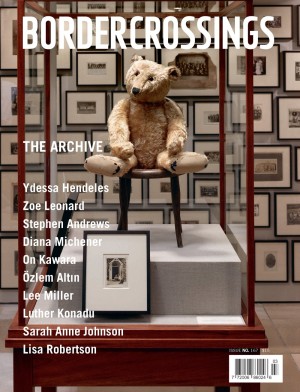Brendan Fernandes
One of the key debates in post-colonial studies centres on the notion of cultural identity, specifically whether a pre-colonial identity can be recovered or whether identity is irretrievably linked to the experience of traversing colonialism. One influential theorist, Stuart Hall, postulates that cultural identity is, in fact, “a politics of position”—in essence, an ongoing process of transformation that responds to ruptures and changing conditions, whatever they are, with no form fixed at some idealized point in the past. “Cultural identities come from somewhere, have histories,” Hall observed, in his essay “Cultural Identity and Diaspora,” 1990, “but like everything which is historical, they undergo constant transformation.” Artist Brendan Fernandes similarly rejects what he views as the notoriously slippery ideology of cultural authenticity, with its seeming promise of stability and certainty. Instead, he appropriates past and present forms of representation to create rich and layered fusions that make reference to the histories of entwined cultures.
It is not, perhaps, a surprising stance for an artist whose life and heritage engage so full a range of cultural expressions. South Asian, with forebears in the former Portuguese colony of Goa, but born in Kenya, Fernandes is an immigrant to Canada who is now based in New York. His recent exhibition, “For My Culture,” at the Alternator Gallery for Contemporary Art, an artist-run centre in Kelowna, BC, navigates the complexities of the post-colonial paradigm by reflecting on the meaning of home, the hybridization of identity, and various systems of cultural exchange. He works with satisfying circularity, offering three nuanced installations that consider the challenges of theorizing the “other.”

Brendan Fernandes, installation view, Alternator Gallery for Contemporary Art, Kelowna, 2008. In background: Homecoming, 2008, digital video projection. In foreground: Neo Primitivism II, 2007, life-sized decoy deer, plastic masks. Photo: Pudy Tong.
Fernandes, who last year completed the prestigious Independent Study Program of the Whitney Museum of American Art, has clearly profited from a period of intense intellectual focus. Everybody may be doing Diaspora, as sociology professor Rinaldo Walcott has observed, but Fernandes positions himself both within and without various subordinate communities, a strong vantage point from which to contemplate the ironies of individual dislocation at a time of unprecedented global connection. His focus is the safari as metaphor for the inscription of culture onto identity. While the safari refers to his childhood in Kenya, it more broadly engages one of the iconic Western distillations of “Africa”—a construct forged in the colonial era and probably paralleled now in the popular imagination only by the pyramids of Egypt. Even Fernandes, in seeking to recall memories of Kenya, which he left at age nine, says he is drawn to stereotypical imagery of safaris as commodified tourist representations, rather than to actual details of his youthful experiences. This insight has influenced his decision to work with mediated and mass-produced forms of representation blanched of traditional claims to cultural authenticity.
Fernandes’s installation, NeoPrimitivism II, features a herd of decoy deer wearing flimsy white plastic masks that he cast from “African” wares sold by street vendors outside his Lower Manhattan studio. The piece, which one might jokingly dub “Les Doe-moiselles d’Avignon” for its parallels to Picasso’s pivotal 1907 painting, draws intellectual sustenance from theorists such as Frantz Fanon, whose 1952 reflection on the divided self, Black Skin, White Masks, remains influential. Visually arresting, the piece also invokes ideas related to mythical hybrids and the contested terrain between nature and culture. This interest in binary constructions— an ideological tool of colonial control that helped subordinate the colonized in relation to the colonizer—is a key to appreciating Fernandes’s work. But whereas the West has traditionally empowered one half of the paired terms—“white” over “black,” say, or “civilized” over “primitive”— Fernandes adopts an ambiguous stance in which binary hierarchies repeatedly shift, an instability that resists the easy categorization of his work as a one-dimensional strategy of resistance.

Brendan Fernandes, Authentic Pop!, 2007, balloons with printed images, helium tank, cardboard boxes, metal cart, ribbon. Installation view, Alternator Gallery for Contemporary Art, Kelowna, 2008. Photo: Pudy Tong.
Fernandes is also interested in the dissemination of culture and how concepts of authenticity are diffused in commercial transactions, whether through tourism or trade, and in informal channels of gifting. In Authentic POP!, he creates a mobile kiosk based on those of street vendors outside his studio and offers viewers white latex balloons printed with stylized drawings of masks from the African collection at the Metropolitan Museum of Art in New York. By facilitating the migration of ephemeral tourist-style souvenirs beyond the gallery, visitors engage with inflated notions of authenticity related to various systems of cultural and commercial exchange. While the installation’s title slyly refers to the commodification of Pop art, it also reflects current popular modes of consumption of the “exotic,” such as the museum gift shop. We are, it seems, less distant from colonial antecedents than we might care to believe, even if the trinkets we choose are plastic.
The ultimate futility of nostalgic attempts to recapture the past is underlined in Fernandes’s third piece, Homecoming. He has mixed the seemingly melancholy roars of lions in a projected loop of appropriated documentary video with the ambiguous directive: “Go home.” But when cultures occupy what post-colonial theorist Homi Bhabha characterizes as a liminal space of reciprocal transformation, a return to a mythical authenticity becomes an elusive goal for “colonizer” and “colonized” alike. You can’t go home again, Fernandes concurs, whatever and wherever home is. He argues the best strategy is to move ahead, retaining what you can of the old while adopting the new. And, with balloons and plastic masks as festive party favours, to celebrate the ongoing project of cultural metamorphosis. ■
“For My Culture” was exhibited at Alternator Gallery for Contemporary Art in Kelowna from February 1 to March 14, 2008.
Portia Priegert is an artist and writer based in Kelowna, BC.

